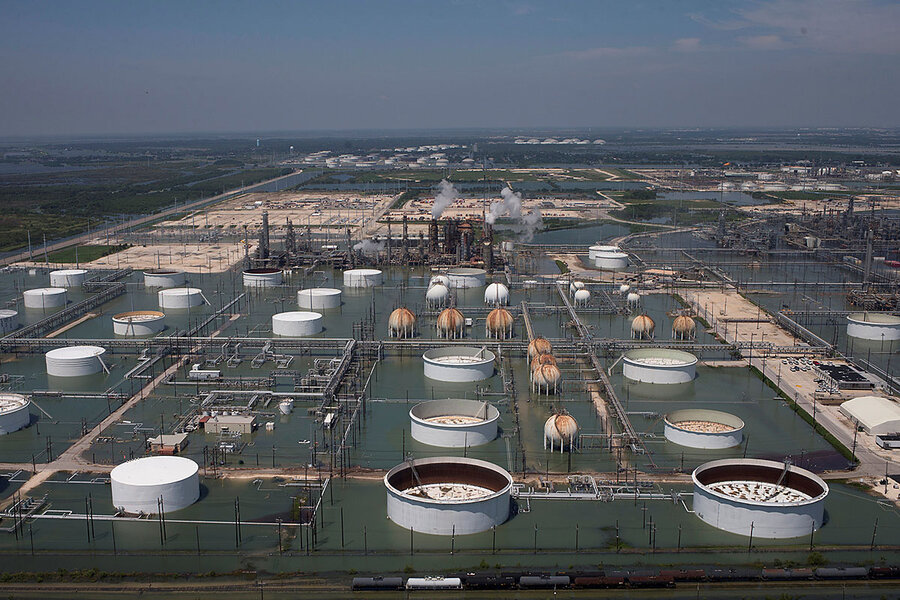US oil industry, stronger than during Katrina, expects rapid recovery from Harvey
Loading...
A week after hurricane Harvey inundated Houston with historic flooding, the price of gas soared 27 cents in the United States. In the South, a gallon of regular gasoline cost an average of 31 cents more, the AAA motor club reported. In Delaware, it jumped 44 cents.
As jolting as those price increases are, they are only about half what the average motorist saw in the week after hurricane Katrina hit the Louisiana coast in 2005. Back then, gas prices leaped to a historic high above $3 a gallon. After Harvey, prices are within a penny of reaching a two-year high: $2.67.
If anyone needed further evidence of how America’s energy picture has improved over the past decade, hurricane Harvey provided it. In 2005, the US was an oil importer and its refineries were stretching to process all of the crude coming in, even before hurricane Katrina hit. Twelve years on, the US is a net oil and gasoline exporter, which gives the industry considerable flexibility. A major reason behind Harvey’s more muted impact on gasoline prices was the ability to redirect US gasoline exports to American markets.
“I'm expecting a quicker recovery than from Katrina,” Guy Caruso, a senior adviser to the energy and national security program of the Center for Strategic & International Studies, told reporters at a webinar Tuesday.
The industry’s challenge now is to take the lessons it is learning from Harvey to minimize disruptions from future hurricanes. At the moment, hurricane Irma threatens gasoline refineries in the Dominican Republic and Cuba rather than the high concentration of refineries along the Texas-Louisiana coast. Thus, while Florida prepares for potential storm damage to homes, offices, and power lines, the main focus for the energy industry for now remains recovery in Houston.
Motorists are not out of the woods yet. The AAA predicts gas prices could go up another nickel or more. GasBuddy.com, a gas-price reporting website, says that peak could come as early as this week.
“While prices may tiptoe higher in some states for several more days at least, the national average is likely to peak later this week,” Patrick DeHaan, senior petroleum analyst for GasBuddy, wrote in a blog Tuesday.
The US has the world’s largest refining capacity and just under half of it is concentrated in Texas and Louisiana (nearly 30 percent in Texas alone). In the wake of the extensive flooding from Harvey, roughly a quarter of the nation’s refining capacity was knocked out. As of Tuesday, six refineries were running at a reduced rate, another refinery had come back online, and five more were in the process of restarting, including the nation’s largest refinery. Also, parts of the Colonial Pipeline, a key distribution channel that brings Gulf Coast gasoline to the Southeast and Middle Atlantic states, have also restarted as of Tuesday.
Just as hurricanes Katrina and Rita in 2005 caused the industry to strengthen offshore drilling platforms, hurricane Harvey is likely to force the industry to bolster the flooding defenses of refineries and other onshore infrastructure.
The lesson to absorb is “what do we do next time to make sure that toxic materials don't get into the water,” says Amy Myers Jaffe, senior fellow for energy and the environment at the Council on Foreign Relations.
A broader solution, such as locating refineries away from the Gulf Coast and closer to major cities, is a nonstarter. For one thing, the Texas refineries were hit but not permanently damaged, Patrick Jankowski, senior vice president of research for the Greater Houston Partnership, told reporters at the webinar. “We're not going to have to rebuild this infrastructure.”
For another, current refineries are strategically located close to oil pipelines and water transportation and there’s little incentive to build a new one because gasoline demand is essentially flat. Also, those refineries continue to find ways to expand capacity. (The last major refinery was built in 1976.)
Attempts to build East Coast refineries during the past four decades have routinely failed, in part because of local and environmental opposition, says Lawrence Goldstein, director of Energy Policy Research Foundation Inc. and a consultant to that 1976 refinery. “If you can't build where you'd like to, you have to build where you can.”
Another solution involves converting a portion of the Strategic Petroleum Reserve, which stores oil in giant underground caverns, into an emergency supply of gasoline. That’s an expensive proposition because gasoline, unlike oil, would have to be stored in above-ground tanks and routinely changed out so that it doesn’t degrade, Mr. Goldstein points out.
But the US could keep costs down by copying the European model, where governments require refiners to store reserves of gasoline on their own facilities, says Ms. Jaffe of the Council on Foreign Relations.









